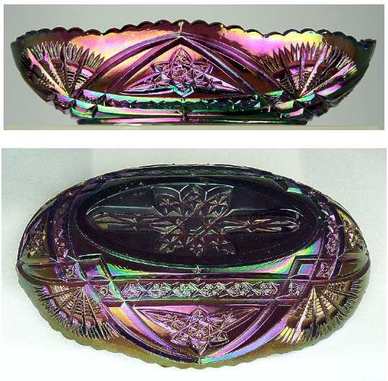Kutzscher and the Brockwitz question
Imitation is the Most Sincere Form of Flattery!
Kutzscher was not a glassmaker, but they were undoubtedly inspired or influenced by existing glass patterns (and shapes). As well as producing their own original designs, some Kutzscher designs were evidently close to (but just a little bit different from) these other patterns. Similarly, some glassmakers would have seen a Kutzscher drawing they admired and subsequently produced their own version of it for themselves.
|
Time and again, looking at glass patterns of the era, we see part of a design, a motif, a shape, and recognise that it’s familiar, that we’ve seen it before. A case in point is the similarity between some known, confirmed patterns made by Brockwitz, and designs that were illustrated in Kutzscher catalogues.
Naturally, the question arises - did Kutzscher make moulds for Brockwitz? The most likely answer is "no", which suggests that Kutzscher used pre-existing Brockwitz patterns as a basis for their own (slightly different) versions of those designs. Brockwitz had a huge mould shop, of which they were rightly very proud. They designed, engineered and produced their own moulds, even registering patents “for the manufacture of moulds”. As early as 1910, there were at least thirty men working in the mould shop – a significantly large number. The Pottery Gazette trip to their factory in 1928 reported that Brockwitz “make all their own moulds and have a huge engineering shop employing an army of engineers and mechanics.” It was clearly something they were proud of, and were possibly somewhat competitive about. |
Let's look at three well known patterns - Rose Garden, Curved Star and Square Diamond - where there are items known to have been made both by Brockwitz and by other makers.
|
Rose Garden
The pattern was in the Brockwitz catalogues from at least as early as 1915 (and probably a number of years earlier - a discovery we reported to the Carnival Glass world in 2005). Yet the pattern was also made by Eda from around 1925, in an “oval” vase shape that was very similar to (but not the same as) the Brockwitz version - as we revealed in "Rose Garden - a Mystery Solved". Records (**) show that Eda and Kutzscher had an ongoing business relationship, so it seems likely that the mould for the Rose Garden vase was made by Kutzscher, almost certainly “inspired” by the earlier Brockwitz design. On the right are the two versions of Rose Garden oval vases: Eda’s version is the one on the left of the two, while the Brockwitz earlier original is on the right. ** “Collecting Carnival Glass” Marion Quintin Baxendale, 1998. |
Curved Star
As with Rose Garden, the Curved Star design was shown in Brockwitz catalogues from 1915 (and was likely made earlier than that) where it was called Zurich.
A range of Curved Star items, with modifications to the design details, was shown in Eda Glasbruk’s catalogue from 1929, where it is called Lasse (a vase in a similar design, called Dagny, was shown in 1925).
Curved Star
As with Rose Garden, the Curved Star design was shown in Brockwitz catalogues from 1915 (and was likely made earlier than that) where it was called Zurich.
A range of Curved Star items, with modifications to the design details, was shown in Eda Glasbruk’s catalogue from 1929, where it is called Lasse (a vase in a similar design, called Dagny, was shown in 1925).
|
It’s highly likely that Eda’s later version of the earlier Brockwitz Curved Star pattern was also made by Kutzscher. Karhula also made a version of this pattern, with another “tweak” to the design (see our ebooks “Carnival Glass from Sweden” and “Carnival Glass from Karhula” for details). The source of the moulds for Curved Star remains unclear. The likelihood is that Brockwitz made their own and that the later Eda and Karhula versions were probably made from moulds that Kutzscher made for them, although Brockwitz remains a possible (albeit an unlikely) source. |
|
Square Diamond We also feel that the Riihimaki version of the Square Diamond vase was probably made using a Kutzscher mould that was “inspired” by the earlier Brockwitz version. Although the design concept is essentially the same, there are many subtle differences between the two makers' versions of the pattern. There is a clear and distinct difference in size, though; the Brockwitz vase stands 8.5 inches high, while the Riihimaki version is only 8 inches. The base diameters are different too; Brockwitz is 2.25 inches x 2.25 inches, while the Riihimaki vase is 2.5 inches x 2.5 inches. Currently the Brockwitz original is only known in blue, while the Riihimaki vase is only known in marigold/amber. Right: Riihimaki’s later version is left and centre courtesy of the Finnish Glass Museum in Riihimaki, and the Brockwitz original is on the right. |
In the last section of our four page feature on Kutzscher we look specifically at:
Kutzscher - Some Questions: We investigate.
Or ... return to:
The Kutzscher Story
Kutzscher Designs: The designs that were born in glass.
Click on any image below
In the last section of our four page feature on Kutzscher we look specifically at:
Kutzscher - Some Questions: We investigate.
Or ... return to:
The Kutzscher Story
Kutzscher Designs: The designs that were born in glass.
Click on any image below







